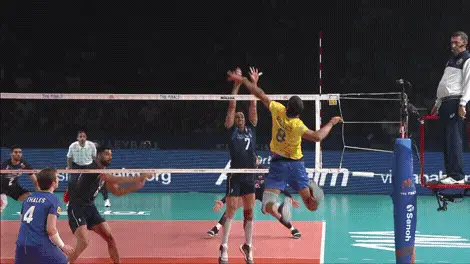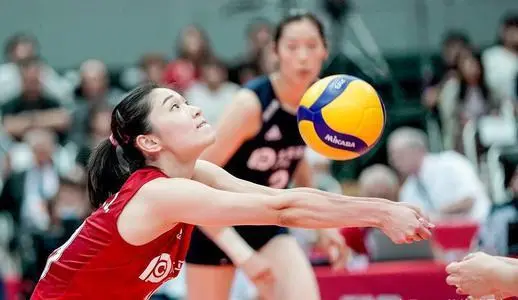Admit it or not, the difficulty of volleyball heavily depends on the position you play. Some roles demand significant responsibility and technical skill, while others are comparatively easier to manage.
I’ve ranked the five main volleyball positions from easiest to hardest to help you understand how these roles function and end your self questioning of ‘what volleyball position should I play?’
If you’re struggling to choose the best position in volleyball, this guide is a great starting point!
What Are the volleyball Positions?
1. Outside Hitter
The outside hitter volleyball position is often considered one of the most demanding roles on the court. The specific role of an outside hitter is to attack the ball from the back row, place it on the opponents’ court and score the point for the team.
This player has to show high jumping capacity and powerful strikes, as well as ability to play under different sets and in various game scenarios.
That is the main difficulty for an outside hitter one needs to be accurate. They’re expected to win and more so deliver a big blow at that moment when your opponent has put up his armory in the form of a block. Besides, outside hitters must also play the front and back row and thus must be good at defense and proper passing of the ball.

Yet, the outside hitter position in volleyball also requires endurance in order to be able to sustain the constant jumps and movements required in the position.
They more often than not take part in both an attacking and a defending role so fitness is a key aspect that they should possess.
Interpersonal skills are mandatory in this position since the outside hitter needs to make decisions in harmony with others, especially setters and other attackers.
2. Middle Blocker
The middle blocker is often regarded as one of the most important positions on the volleyball court. This player is mostly involved in defending and protecting the team’s side from the aggressive attacks of the opposite team, in particular quick middle hits.
The middle blocker position consequently demands excellent game vision and anticipation and fast reflexes to create the right blocks.
That means a middle blocker does not only get to participate in defending plays of the opponent’s team only. Offensively they are useful in conducting probes, they charge and perform quick strikes, which could cause the opposition’s downfall due to the blows that they inflict.

This can only be done with great timing in conjunction with the setter and jumping prowess with as much velocity as possible. The mature posted player must be large and muscular in stature, this is because they are almost involved in blocking as well as attacking.
The flexibility of the middle blocker as a player in that he or she is involved in almost every play poses one of its biggest trials.
Every attack and maneuver are both offense and defense in the same move and as such require the football players to be very energetic and quick. One must coordinate with his teammates so as to have right blocking for a perfect attack.
3. Opposite/Right Side
The opposite hitter or the right-side hitter is also a very important player that has responsibilities on the offense as well as the defense. This player is mostly found on the right side of the court, and they frequently set the ball when the setter makes the first contact.
The opposite hitter should be able to pack a strong and powerful attack to spike the ball from his right side especially against the best blockers on the other team.
They’re equally important in defending plays, especially by stopping the opponent’s outside hitters, which may require swift movements and proper positioning. The right-side hitter is rather a versatile position on the court that requires using the most of both offense and defense.
4. Setters
There’s little dispute over what is the hardest position in volleyball…
And to top it, the setter is widely acknowledged as the most challenging role. Setters bear more responsibility than any other player on the court. They serve as the crucial link between the backcourt and frontcourt. A poor performance by the setter can lead to even worse spiking.

Setters are the strategic minds of the game, requiring quick thinking and precise execution. Their ability to read the game and make split-second decisions directly impacts the team’s offensive effectiveness. Without a skilled setter, the team’s coordination and overall performance suffer significantly.
5. Libero
The libero position in volleyball is unique and highly specialized, focusing entirely on defensive skills. This player is the main pillar in the defensive line and has the role of receiving serves and setting the first ball for the setter.The libero must have exceptional reflexes, agility, and ball control, as they often handle the most challenging defensive plays.
Another big, critical role possessed by the libero is to move to the back and hence ensure that the ball remains in play.

Depending on the side they belong to, they are dressed in different-colored jerseys and cannot perform a third touch to attack a ball above the height of the net. This position therefore has to think on its feet and also read the flow of the game well.
If you have strong defensive skills and enjoy being the core of your team’s success, the libero might be the best position in volleyball for you.
6. Defensive Specialist (DS)
The defensive specialist (DS) is an important position on the roster because of the constraints on defense that is mandated as its main task. As we understood, the rules do not allow the libero to attack or be in the front zone while the DS is limited to the back zone but can jump to the front.
Some of the specific tasks that the players carry out are to dig the attacks besides serving and setting from the back of the court in a precise manner to the setter.
A defensive specialist is required to have quick response to shots, good coordination, and well developed interpersonal communication to relay moves and positioning with other players on the court.
This is usually a relief for teams that have players with less defense capability in their teams, especially when making a decision during game time. In this position, the player has to be very perceptive with the ability to predict the move of the opponent’s offenses.
As a DS, one must be prepared for powerful spikes and delicate serves; therefore, it is a physically and mentally strenuous position.
If you have a passion for defense and enjoy playing a pivotal role in your team’s success, the defensive volleyball positions might be perfect for you.
7. Serving Specialist
The serving specialist should be noted as an important contributor that focuses on generating strong and effective serves. The ‘Player Serving’ position is ideal for those players who are good servers and who can deliver services in ineffective areas of the opponent’s court.
It can cause great uneasiness to the rivals and complicate their movements on the field due to the desire to save the ball.
The service specialist is usually employed specifically for serving, thereby filling this role in many cases, replacing players who are not so strong in this aspect.
In this way, your aim is to get aces or, in the worst-case scenario, make your opponent make a mistake. Hence, this involves accuracy, discipline, and a good heart to cope with adversity of this kind.
Serving specialist is perfect for you if you have an excellent serve and like to make an opponent uncomfortable. A position which can decide the game with good serve, and at the center of this play makes you an essential player in the team.
How Positions Rotate in Volleyball?
In volleyball, each team has six players on the court, each occupying a specific spot that differs from their designated positions (setter, middle blocker, outside hitter, opposite, or libero). Except for the libero, players rotate through these spots in a clockwise direction before each serve.
Front row players, located near the net, focus on blocking and hitting, while back row players, situated in the middle or back of the court, handle digging and defense.
Notably, back row players (excluding the libero) can attack the ball, provided they jump before the attack line.
Rotation occurs each time a team wins a point or starts serving, with players moving clockwise. If players switch spots before the ball is served, they are penalized for overlapping or being out of position, awarding a point to the other team.
If the faulting team was serving, the serve goes to the opposing team. Therefore, players must be aware of their positions and ensure correct alignment with teammates.
Player positions are determined by foot placement. Each front row player must have one foot closer to the net than the player directly behind them. Rotations occur with each serve, typically starting with the right-back (RB) player as the server. If the serving team wins the point, the same player continues to serve until the point is lost.
FREQUENTLY ASKED QUESTIONS
1.What are the 7 positions in volleyball?
The seven positions in volleyball are setter, middle blocker, outside hitter, opposite hitter, libero, defensive specialist, and serving specialist.
2.What is the hardest position in volleyball?
The setter is widely regarded as the hardest position due to the high level of responsibility and technical skill required.
3.What is the most important position in volleyball?
The setter is often considered the most important position because they orchestrate the team’s offense and coordinate plays.
